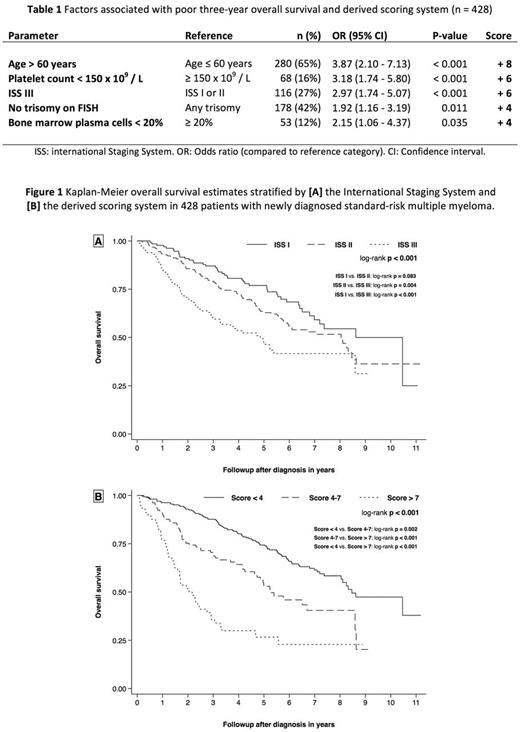Abstract
Background:Despite the absence of cytogenetic high-risk abnormalities on fluorescence in situ hybridization (FISH) evaluation, a subset of patients with newly diagnosed multiple myeloma does experience poor overall survival. We aimed to identify demographic, clinical, and cytogenetic characteristics predicting poor three-year overall survival in patients with newly diagnosed standard-risk multiple myeloma.
Methods: We studied 428 patients who were diagnosed with multiple myeloma between July 2004 and July 2014 at Mayo Clinic Rochester, underwent FISH evaluation within six months of diagnosis, and received treatment with novel agents. Patients with high- and intermediate-risk cytogenetics as well as patients lost to follow-up within three years were excluded. High-risk cytogenetics were defined as del(17p), t(14;16), and t(14;20). Intermediate-risk cytogenetics were defined as t(4;14) and dup(1q). A multivariable-adjusted logistic regression model was used to assess the associations between the parameters of interest and three-year overall survival. The identified predictors were used to derive a numerical scoring system. Receiver operating characteristic analysis was used to determine the optimal cut-off and associated score performance characteristics. Cox regression models were used to compare the derived scoring system to the established International Scoring System (ISS).
Results: The median overall survival was 7.4 years (6.1-8.6) for the entire cohort (n=428), 10.5 years (8.3-NR) for those who survived at least three years (n=327, 76%), and 1.6 years (1.3 - 1.7) for those who did not survive three years after diagnosis (n=101, 24%). The prediction model had good discrimination (c=0.75) and adequate calibration (p=0.538). Scores were assigned based on the factors independently associated with poor three-year overall survival (Table 1): Advanced age (+8), advanced stage (+6), thrombocytopenia (+6), the absence of trisomies on FISH (+4), and low bone marrow plasma cells (+4). The scoring system had identical discrimination (c=0.75, 95% CI 0.70-0.81; internal cross-validation c=0.76, 95% CI 0.70-0.82). A cut-off of ≥8 (75% of the patients) yielded a sensitivity of 94% (95% CI 88-98) translating into a negative predictive value of 94% (95% CI 88-97). Risk strata based on the scores had better predictive power than the International Staging System alone (p=0.009, Figure 1).
Conclusions: Patients with standard-risk multiple myeloma are a heterogeneous population. One fourth of the patients are experiencing less than three years of overall survival after diagnosis. Five readily available factors were helpful in identifying patients at risk for early death. These findings emphasize the importance of further risk stratification in this patient population and warrant external validation.
Dispenzieri: Celgene, Millenium, Pfizer, Janssen: Research Funding. Lacy: Celgene: Research Funding. Gertz: Millennium: Consultancy, Honoraria; Celgene, Novartis, Smith-Kline, Prothena, Ionis, Amgen: Honoraria. Leung: Prothena: Consultancy. Kapoor: Takeda, Celgene and Amgen: Research Funding. Kumar: Celgene, Millennium/Takeda, Onyx, AbbVie, Janssen, Sanofi, Novartis, Amgen, Genentech, Merck, Oncopeptides, Roche, Skyline Diagnostics: Research Funding; Celgene, Millennium, BMS, Onyx, Janssen, Noxxon, AbbVie, Amgen, Merck, Oncopeptides, Skyline Diagnostics, Takeda: Consultancy; Skyline: Honoraria.
Author notes
Asterisk with author names denotes non-ASH members.


This feature is available to Subscribers Only
Sign In or Create an Account Close Modal